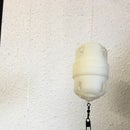Introduction: Easy MDF Wood Joints - Speaker Cabinet Enclosure Without Screws
There are many wood joints available although some work better than others depending on the desired function. When making a wood speaker enclosure, MDF is a great choice. The material is flat, stable, and dense - great for sound reinforcement. In fact, the time spent to properly design a stable enclosure is as important as the calculations and speaker driver selection.
I've made a lot of enclosures as a hobby and admittedly, butt joints and screws were used often and this is very typical for speaker enclosures. The problem is a butt joint is not strong or easily squared properly and may not properly seal. Oh sure, you can shove glue or caulking to 'seal' the enclosure but why not design the box properly to begin with? Secondly, screws are not cosmetically appealing and many times need to be filled before final surface preparation - so again, time spent on design of a proper enclosure will result in a rewarding and stable end product.
This instructable is not intended as a complete wood working or speaker enclosure design, rather I wrote it to provide a few tips so that your next project may also go together better.
Step 1: Joints and Dimensions
The joints I like to use best for MDF cabinet construction are dado and rabbet joints. The two types are very similar and the difference being that dado joints are used in the middle of a board whereas rabbet joints are used along the board edge. Both joint types provide overlay of material - essentially a 'tongue and groove' that increases the surface area making them perfect for a glued application. In addition, since these joints are made using straight edges, making a perfect rectangle box is much easier.
Step 2: How They're Made
These joints can be made using a table saw and a dado blade either as a stack blade set or as a wobble blade. the second option is using a router with an edge guide and a bit the same diameter as the thickness of the material you are using.For example, if you are using 3/4" material, you will require a 3/4" diameter bit to properly make a slot that will accept the material width. While it is possible to use a smaller diameter bit and a smaller stack of blades than the final width, I would suggest you use the correct tools for the job - do it once and do it right. In this case, a single setup for all rabbets is much better than taking multiple passes to creep up on the width.
Carefully measure the width and depth using scrap wood and NOT your panel. Adjust the settings on this scrap wood until the groove is very close to the desired size. A good joint is one with a snug fit but without the aggressive use of a hammer - slight taps with a dead blow are OK but not tighter otherwise you will damage the joint or panel. Likewise, if the gap is too loose be sure to narrow the gap otherwise you lose the benefit of this type of joint and your overall project will not fit together well.
The depth is also important. This should be 1/2 the material thickness. Any more or less and the overall dimensions of your box will be off.
Step 3: Determining Final Cabinet Size
It is important to take into account the joints depth when determining the final cabinet size. Since the joint removes 1/2 to full material thickness (depending on where the joint is placed), this must be taken into account for an accurate overall height, width, depth, and cabinet volume. Review the desired cabinet size and add back to the height and/or width to the boards the material removed. As long as you are aware of that your final cabinet dimensions will change from those assuming a butt style joint (end to surface) this is not a problem. The problem comes into play if you don't take these joints into account of you overall project.
Step 4: Short Dato Cuts
Sometimes you may want a cut to stop before going off the edge of the board. The best way to do this is to mark the end of the bit on the edge guide and secondly mark the desired stopping point on the board. By doing so, some boards will stop at the mark and for opposite cuts you will need to drop the board onto the tool bit and cut the slot in reverse - this can be tricky - be careful..
Step 5: Glue and Clamp - That's It...
Now that all of your parts are cut and fit properly, Dry fit all parts before you glue and clamp - also be sure to check all 90 degree angles by measuring corner to corner. Depending on your project, you may want to glue in sections rather than the entire assembly at once to minimize the clamping effort.
If you are interested in learning more about the speaker project shown or to get the plans to build your own, the video can be found in the link below: 6.5" 2-Way Loud Speaker Project
Project plans can be found here at: Britz Designs on Etsy
Thanks for looking!
Bret













